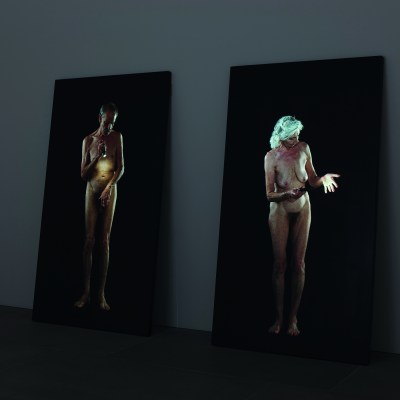Bill Viola has died at the age of 73. Known for making video art with an evocative interplay of sound and image, often in slow motion, he made his first work while completing a bachelor’s in experimental studies at Syracuse University. Viola was the first video artist to put on a solo show at the Museum of Modern Art in New York, in 1987, and has been the subject of more institutional shows than most video artists. He represented the United States in the Venice Biennale in 1995. Viola frequently collaborated with his wife, Kira Perov, who survives him. Jonathan Griffin interviewed Viola for our March 2014 issue.
When Bill Viola talks about his art, he refers to it as ‘our work’. He and his wife, Kira Perov, have been working together since they met in Melbourne, Australia, in 1977. The first thing Viola tells me, when I sit down with him at his studio in Long Beach, California, is that it is most important that my interview include Kira.
In 1977, Viola (b. 1951) was only four years out of his undergraduate degree at Syracuse University, but he was already a fast-rising star in the still nascent genre of video art. Early adopters, in the late 1960s, of the new Sony Portapak technology (which allowed a cameraman to record without being tethered to a mains video deck) included Nam June Paik (1932–2006) and Peter Campus (b. 1937), both major influences on Viola. The younger artist distinguished himself, however, with meditative, mystical compositions that had more in common with still-life painting or religious icons than with contemporary media studies and the fields of experimental film and performance that informed the work of his predecessors.
Viola and Perov settled in California in 1981 after falling in love with the desert landscapes of the American Southwest. Visiting Death Valley for the first time, Viola says, was ‘a life-changing experience’. Standing in its vast and other-worldly expanses is, for him, transportive, ‘like you’re not really here’. The sensation appeals to the artist who, though he has shot videos all around the world, never allows locations to get in the way of human narrative. ‘The place itself is not important,’ he says. ‘In anything I do, it’s really about the inner place. The outer place is, for me, a backdrop. I don’t feel that deeply embedded in the physical world.’
Luis Accinelli in Man Searching for Immortality/Woman Searching for Eternity (2013) by Bill Viola. Photo: Kira Perov; © Bill Viola Studio
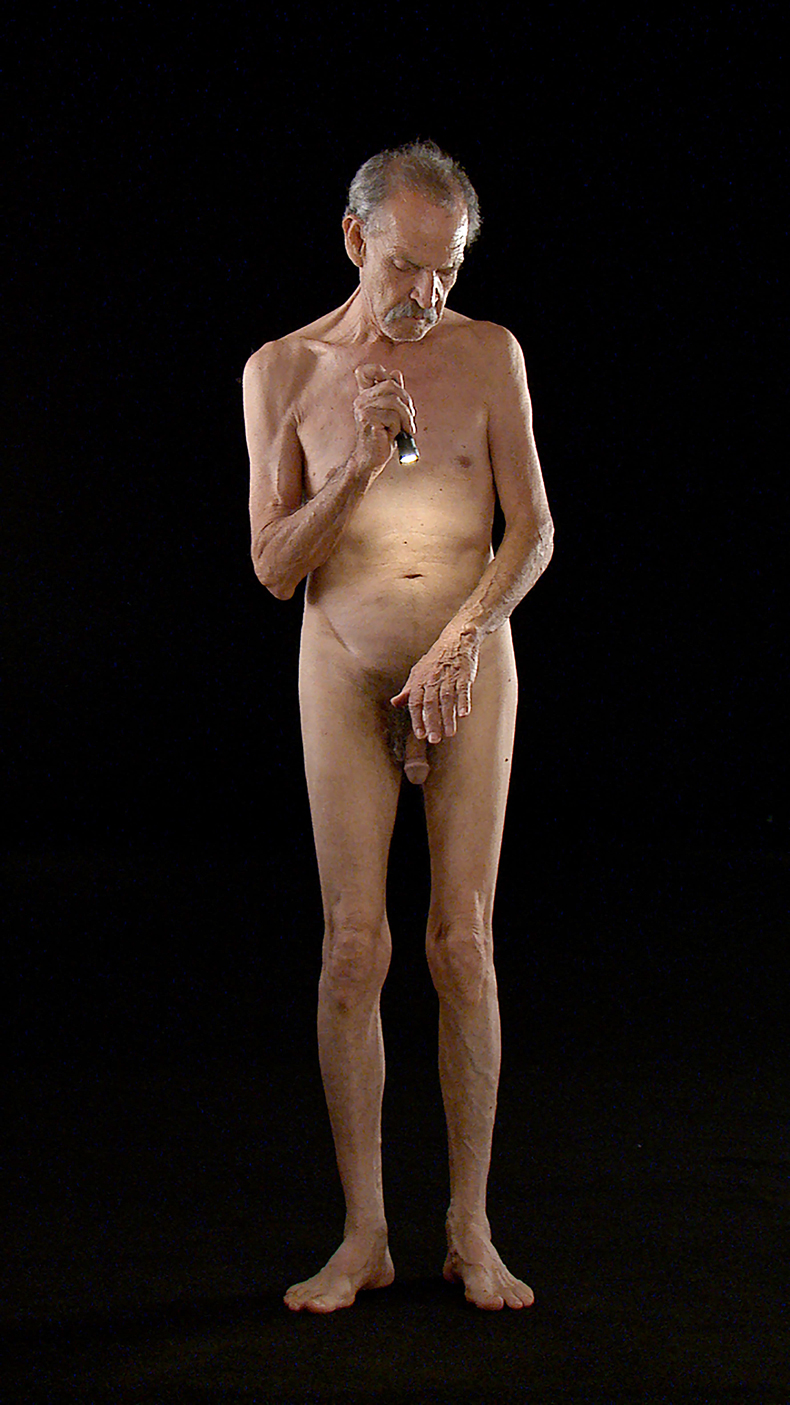
That may explain why Viola was content to live and work not on some remote desert ranch, but in the industrial harbour town of Long Beach, half an hour south of Los Angeles. In the charmless business park where his studio is located, oil derricks nod balefully in empty lots beside the road. ‘I don’t like big crowds,’ he says. ‘I don’t want to be in the middle of things. I want to be by the sea, or at least where there’s water. There’s a nice marina here.’ He keeps a low profile within the Los Angeles art scene. Does he even consider himself a Californian artist? ‘I really don’t know,’ he answers.
In their early years together, Perov jokes, Viola would simply tell her: ‘You carry the Portapak and I’ll do the camerawork and just make sure you record some sound!’ Today she bears the formal title of Executive Director of Bill Viola Studio, but, she tells me, ‘normally I just say “partner and collaborator”’. Her diverse roles include running the studio, managing Bill’s often logistically grandiose productions, overseeing publications and co-ordinating exhibitions. She is also the co-curator, alongside Jérôme Neutres, of the major retrospective that opens this month at the Grand Palais, Paris (5 March–21 July 2014).
There is seemingly no part of Viola’s output in which she does not have a hand, but ‘in terms of the work, it’s Bill’s work,’ says Perov. ‘I’m kind of like a midwife.’ He nods in agreement. There is a wealth of precedents in which male artists have latterly credited their partners as collaborators – Ilya and Emilia Kabakov, Christo and Jeanne-Claude, Ed and Nancy Kienholz, Claes Oldenburg and Coosje van Bruggen, to name but a few. Viola and Perov, however, are as yet unprepared to share equal billing.
Nevertheless, ‘I actually influence which works get made and don’t get made,’ Perov says. ‘And very often I’m a creative influence as well.’ She cites the example of their forthcoming four-screen video project Martyrs, for St Paul’s Cathedral, London, which will be unveiled in May after long delays. ‘Bill had these wonderful drawings from a while ago, as part of the proposal, and I knew that we needed to get the production started as we didn’t have a lot of time. Bill was preoccupied with other stuff he was doing, and I started working on it, and thinking about it. Just from the drawings I was trying to imagine how they would come to life as video.’ Perov hit upon the idea of combining Viola’s drawings of four martyrs with the elements of earth, air, fire and water.
Kira Perov and Bill Viola in 2014. Photo: Ye Rin Mok; courtesy Kira Perov and Bill Viola
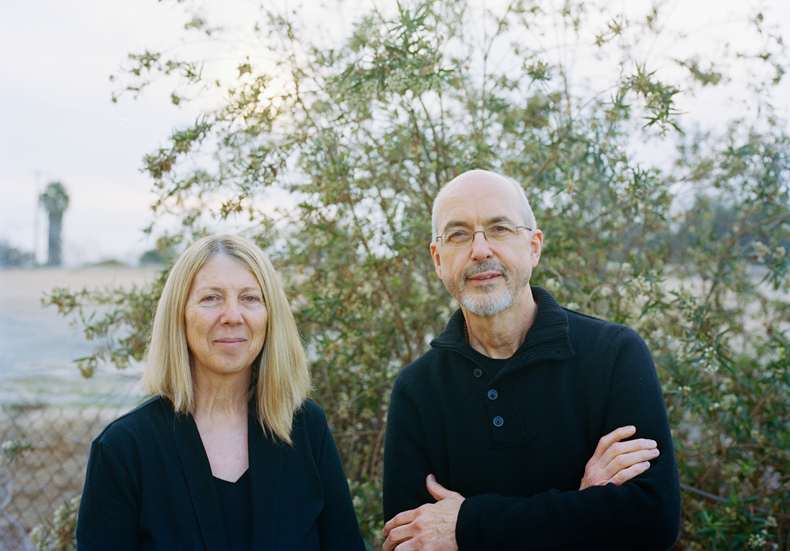
Viola has used elemental motifs in his work many times before. In The Messenger, a video installation created for Durham Cathedral in 1996, a naked figure floats up through blue-black water, gasps for air as he breaks the surface, and sinks back down. That same year Viola created The Crossing, in which a man is engulfed by flames licking up from below and, on the other side of a freestanding screen, is obliterated by a deluge of water falling from above. The pieces are typical of the artist’s reduced aesthetic vocabulary, through which he creates tightly controlled images that aspire to capture certain essential qualities of universal, existential experience.
‘Ultimately, the pieces make themselves,’ says Perov. It is easy to imagine how, after nearly four decades, the couple’s collaboration has assumed a momentum all of its own. Viola acknowledges the influence of Tanaka Sensei, the Zen teacher with whom he and Perov studied in Japan, in the early 1980s. The Zen notions of emptiness, of repose and of the absence of ego, all deeply impressed him. ‘The Japanese have a word for the space between the trees and the forest. They know about that. That kind of emptiness is exactly where you need to be, especially in art making. You want to make sure that it’s not just ego that’s coming out of you, all of the time.’
The studio of Bill Viola and Kira Perov in 2014. Photo: Ye Rin Mok; courtesy Kira Perov and Bill Viola

When Viola was invited by opera director Peter Sellars to collaborate on a 2004 production of Wagner’s Tristan und Isolde, he and Perov had barely eight and a half months to shoot and edit over four and a half hours of video. While Viola worked with the libretto in hand, there was not time to match his moving imagery – some of which was drawn from his archive of past work – with the timing of the music. So they were delighted when, at several pivotal points in the opera, the narrative, the music and the video backdrop happened to coincide with uncanny synchronicity. There are many such moments, says Viola, when he steps back and asks himself ‘Did I do that?’
Viola likes to refer to ‘the Zen doctrine of no mind’. Japanese samurai, who fought with some of the sharpest swords ever made, knew that to pause to think in mid-battle would mean instant death. Instead of reacting with what Viola calls the ‘talkative mind’, a samurai would think with his gut. This philosophy, says the artist, ‘leaves you open to whatever’s happening, wherever you are’. When I ask Viola if he is a visionary artist, he answers without hesitation. ‘Yes. It’s all about vision. Inner vision. I don’t typically work from the outside world.’ Images ‘pop’ into his brain at the moments he least expects, such as when he is sitting down at his desk with a cup of tea. Sometimes, as with his recurrent use of submerged figures, they draw on experiences that are lodged in his subconscious, such as the time when, as a child, he nearly drowned in a lake. ‘Basically, these are pieces that I have been with for a long, long time,’ he says. This is why, ultimately, Viola is the source of these works, why it is his name on the catalogues and the exhibition posters, and why Perov is designated as the ‘midwife’.
It is clear, too, that artworks come to Viola in a wide variety of ways, not only from his subconscious. He is deeply influenced by devotional art, especially Christian painting from the Renaissance. Perhaps his most ambitious production to date was the five-screen installation Going Forth by Day (2002), which was commissioned for the Deutsche Guggenheim, Berlin. One of the five videos, titled The Voyage, was a faithful reconstruction (on a sound stage) of a house copied from Giotto’s frescos for the Scrovegni Chapel in Padua. Inside the house, an elderly man lies dying in bed while his son and daughter-in-law look on. Meanwhile, on the shore of a lake outside, his possessions are being loaded onto a barge, which soon he too boards and sets sail across the water. The allegorical piece was conceived while Viola was mourning the passing of his father.
A still from The Voyage, from the series Going Forth by Day (2002) by Bill Viola. Photo: Kira Perov; © Bill Viola Studio
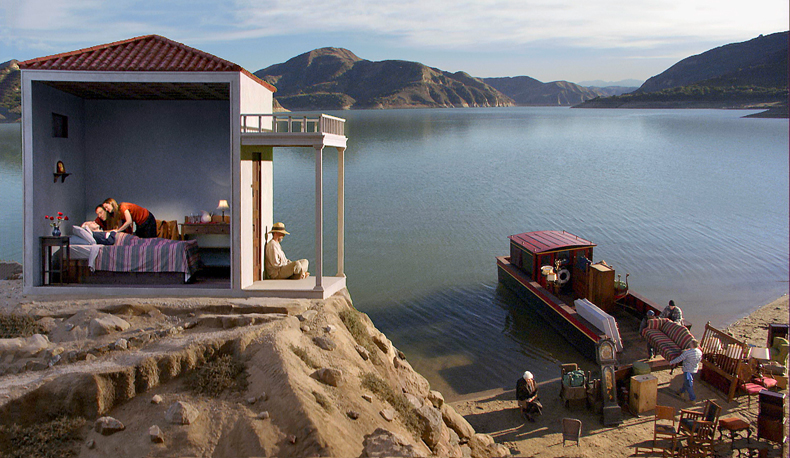
Perov points out that Viola is also frequently inspired by his reading, specifically by his study of texts relating to mysticism and esoteric religious thought. The title of the installation Ocean Without a Shore (2007) was inspired by a line from the 13th-century Sufi mystic Ibn ’Arabi: ‘The self is an ocean without a shore. Gazing upon it has no beginning or end, in this world and the next.’ Viola’s piece involved the creation, in his Long Beach studio, of a flawless curtain of falling water, which was so transparent that only when a body touched it did the glassy water explode into a cascade of droplets. On three large plasma monitors, a succession of people including Viola’s son Blake advance out of darkness towards the viewer, filmed in grainy black and white by an ancient surveillance camera bought by the artist at a flea market. As they pierce the hitherto invisible wall of water, their images seamlessly transition into high-definition, full colour.
In order to achieve this effect, Viola’s team was aided by technicians from James Cameron’s Los Angeles production studio. Viola claims to be uninterested in Hollywood, and insists that the reason he moved to the region was for its incredible landscapes rather than the dominant local industry. That said, it has been useful to have such a wealth of technical expertise on his doorstep. Another video within Going Forth by Day was titled The Deluge. In it, the façade of a house is dramatically flooded from within, causing stuntmen to be swept down the stairs and through its open front door. Viola shot the video in the car park of Long Beach Airport, with a gigantic tank and pump system specially built by the local company Rain for Rent.
Stuntmen aside, Perov says, she tends not to hire movie or television actors, preferring instead to work with theatre companies and performance artists. Even in works such as The Quintet of the Astonished (2000), in which five actors assume a sequence of emotional expressions from joy to despair, she says that, rather than act per se, ‘we asked them to look inside themselves’. Many of Viola’s videos – including Ocean Without a Shore – depict protagonists undergoing genuine physiological experiences, such as walking through a wall of water or holding their breath for long periods of time.
A still from The Quintet of the Astonished (2000) by Bill Viola. Photo: Kira Perov; © Bill Viola Studio
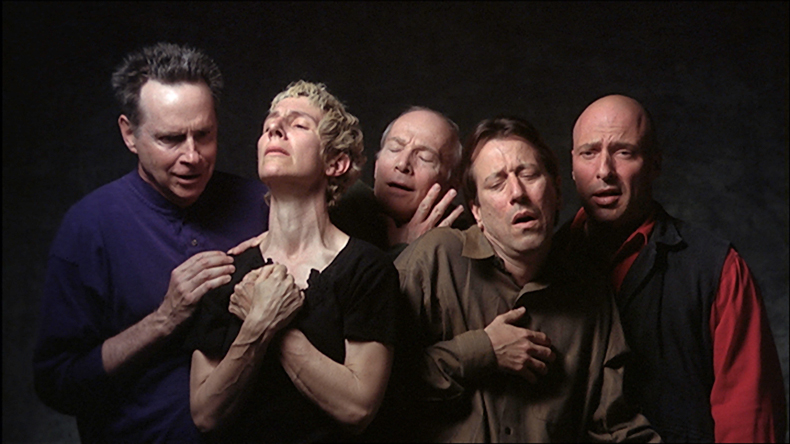
‘When I was young,’ says Viola, ‘I didn’t want any part in movies or theatre – I told myself I’d never go there. Then at a certain point I felt almost that I needed someone to be another me, who I could control from the other side of the camera.’ Since his earliest videos, it was almost always the artist himself who appeared in his work. Then, in 1996, Viola made The Crossing with a man who looked rather like him, and many viewers simply assumed that the man was the artist. Today, he says, ‘I consider acting to be something really special. Acting is the sum total of experience, but pared down to these unique elements.’
The Quintet series, which included four separate videos shown on high-definition LCD monitors, relied on a high-speed film camera that was able to shoot at a fast frame rate and then play back the footage, smoothly, at glacial slowness. Viola wanted the images to look like photographs or paintings; with video, the effect was impossible. His relationship to technology is pragmatic and flexible. Although he chooses the very latest equipment to produce and display his images, his hope is for the hardware to disappear. He is exasperated by the younger generation’s infatuation with all things tech. ‘It’s about what’s in your heart and soul, what you want to do with that, where you want to take that. Technology’s just some tool.’
When he looks back on four decades of technological evolution in his work, as he will soon at the Grand Palais, he says he sees ‘a continuous stream, from the beginning to the end’. It does not bother him that the image quality of the earliest work in the show, The Reflecting Pool (1977–79), is today eclipsed by the cameras in smartphones. ‘I don’t think anyone will even notice,’ says Perov. ‘They’ll just be looking at the pictures.’
A still from The Reflecting Pool (1977–79) by Bill Viola. Photo: Kira Perov; © Bill Viola Studio
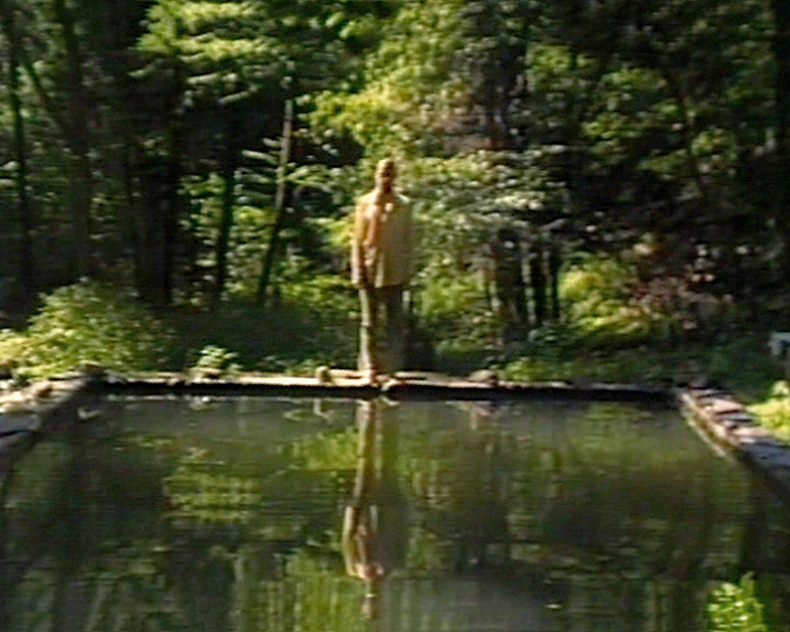
The exhibition, which brings together 20 of Viola’s most important works, will be divided into three sections, each themed around an existential question: ‘Who am I?’ ‘Where am I?’ and ‘Where am I going?’ These questions were suggested by Neutres in response to the ‘journey’ through the work proposed by Perov. After The Reflecting Pool, visitors walk through installations including Heaven and Earth (1992), in which footage of a dying woman is reflected in the face of a newborn baby, and The Veiling (1995), a double projection of walking figures on hanging layers of translucent scrim, which, on my visit, was temporarily installed in the studio.
In the section ‘Where am I?’ viewers find videos set in sublime locations such as a Tunisian dry salt lake in Chott el-Djerid (A Portrait in Light and Heat) (1979), or the dry lake bed El Mirage, in the Mojave Desert, in The Encounter (2012). The question ‘Where am I going?’ is answered, unflinchingly, by the diptych Man Searching for Immortality/Woman Searching for Eternity (2013), which was recently exhibited at Blain|Southern Gallery, London. On two black granite slabs, life-sized projections of an elderly man and woman show them passing torches over their naked, ageing bodies. Finally, their images turn grey, and they pixellate and dissolve into the granite: dust to dust. The show ends with Ascension (2000), a man who plunges, and slowly floats up, through blue-black water, and The Dreamers (2013), seven plasma screens showing people seemingly asleep underwater, lying on a riverbed.
‘I guess one could say that this last part has to do with eternal life,’ says Viola. Much has been made, over the years, of his pantheistic spiritual beliefs, and so I ask him directly: does he believe in life after death? ‘I would say that I believe in… Yes. I would say that life after death is exactly that right there,’ he says, pointing to a reproduction of his iconic work, Nantes Triptych (1992). A man floats underwater, flanked by images of a baby being born and a woman, Viola’s own mother, close to death. ‘That’s someone dying, that’s someone being born, and somewhere in between you have this space – I don’t know what to call it even – life-death? It’s a space that is both physical and spiritual, and that’s where you exist for a short period of time.’ And then? ‘Then your molecules get scrambled and you come back as something else.’
A still from Ascension (2000) by Bill Viola. Photo: Kira Perov; © Bill Viola Studio
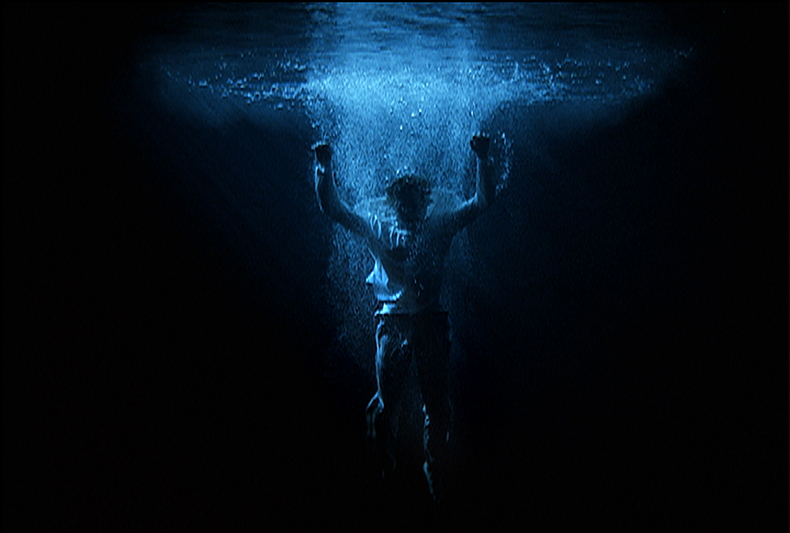
From the March 2014 issue of Apollo. Preview and subscribe here.

